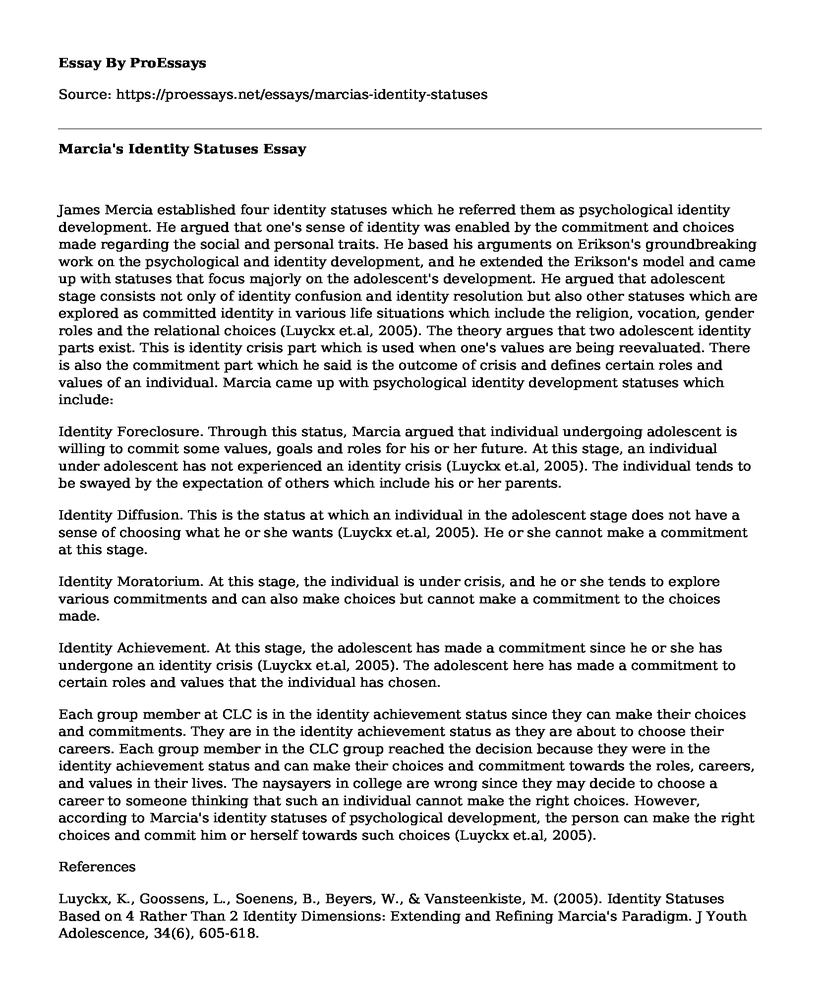James Mercia established four identity statuses which he referred them as psychological identity development. He argued that one's sense of identity was enabled by the commitment and choices made regarding the social and personal traits. He based his arguments on Erikson's groundbreaking work on the psychological and identity development, and he extended the Erikson's model and came up with statuses that focus majorly on the adolescent's development. He argued that adolescent stage consists not only of identity confusion and identity resolution but also other statuses which are explored as committed identity in various life situations which include the religion, vocation, gender roles and the relational choices (Luyckx et.al, 2005). The theory argues that two adolescent identity parts exist. This is identity crisis part which is used when one's values are being reevaluated. There is also the commitment part which he said is the outcome of crisis and defines certain roles and values of an individual. Marcia came up with psychological identity development statuses which include:
Identity Foreclosure. Through this status, Marcia argued that individual undergoing adolescent is willing to commit some values, goals and roles for his or her future. At this stage, an individual under adolescent has not experienced an identity crisis (Luyckx et.al, 2005). The individual tends to be swayed by the expectation of others which include his or her parents.
Identity Diffusion. This is the status at which an individual in the adolescent stage does not have a sense of choosing what he or she wants (Luyckx et.al, 2005). He or she cannot make a commitment at this stage.
Identity Moratorium. At this stage, the individual is under crisis, and he or she tends to explore various commitments and can also make choices but cannot make a commitment to the choices made.
Identity Achievement. At this stage, the adolescent has made a commitment since he or she has undergone an identity crisis (Luyckx et.al, 2005). The adolescent here has made a commitment to certain roles and values that the individual has chosen.
Each group member at CLC is in the identity achievement status since they can make their choices and commitments. They are in the identity achievement status as they are about to choose their careers. Each group member in the CLC group reached the decision because they were in the identity achievement status and can make their choices and commitment towards the roles, careers, and values in their lives. The naysayers in college are wrong since they may decide to choose a career to someone thinking that such an individual cannot make the right choices. However, according to Marcia's identity statuses of psychological development, the person can make the right choices and commit him or herself towards such choices (Luyckx et.al, 2005).
References
Luyckx, K., Goossens, L., Soenens, B., Beyers, W., & Vansteenkiste, M. (2005). Identity Statuses Based on 4 Rather Than 2 Identity Dimensions: Extending and Refining Marcia's Paradigm. J Youth Adolescence, 34(6), 605-618.
Cite this page
Marcia's Identity Statuses. (2021, Mar 19). Retrieved from https://proessays.net/essays/marcias-identity-statuses
If you are the original author of this essay and no longer wish to have it published on the ProEssays website, please click below to request its removal:
- Experience From Your Life That Changed the Way You Think Essay
- Ethics Auditing Essay Example
- Essay Sample on Van der Kolk and Psychology
- Essay Sample on the Five Stages of Grief an Examination of the Kubler-Ross Model
- Essay on the Impact of Emotional Mood on Working Memory and Executive Control
- Essay on Unlock the Power of Game Theory: A Course Exploring Real-Life Applications
- Essay Example on Determinism: Everything is Pre-Determined, But Reality?







